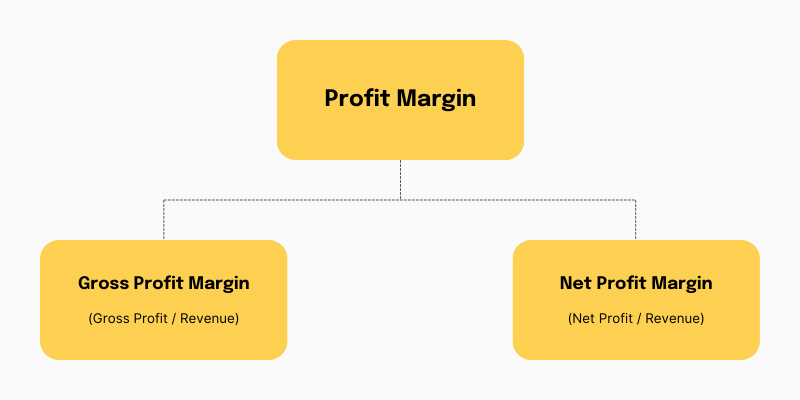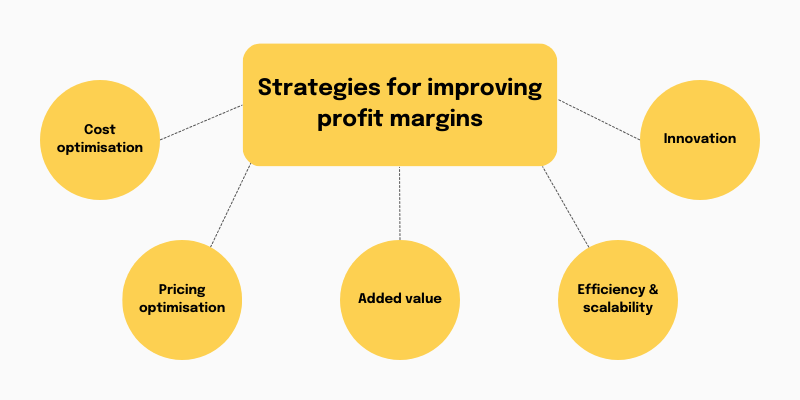Jump to a section
For any business, profitability is essential for long-term survival and growth. One key metric to measure this is your profit margin. Understanding what constitutes a good profit margin and how to calculate it will allow you to set realistic targets, identify areas for improvement, and make informed decisions about pricing, costs, and operations. Let’s take a look at what a profit margin is and how you can use it to help your small business thrive.
Key takeaways
- Calculate and monitor your profit margins regularly to identify areas for improvement
- Benchmark your margins against competitors and industry averages to set realistic targets
- Implement strategies like cost optimization, pricing adjustments, and operational efficiencies to boost margins
- Balance growth ambitions with protecting margins - expand steadily in line with existing profitability
Defining profit margin
Your profit margin is a percentage that shows how much of your total sales revenue is actual profit after you account for all costs of running your business. The higher your profit margin, the more money your business gets to keep from its total sales.
The formula to calculate profit margin is: Profit Margin = (Revenue - Costs) / Revenue
Revenue is the total income your business makes from selling products or services. Costs include everything you spend money on to make your products/services and operate the business, like materials, labour, rent, etc.

There are two common types of profit margin:
- Gross Profit Margin = (Revenue - Cost of Goods Sold) / Revenue - This accounts just for direct costs tied to producing your product/service.
- Net Profit Margin = (Total Revenue - Total Expenses) / Total Revenue - This is your bottom line profitability after all costs and expenses are deducted.
Net profit margin shows your overall profitability, while gross margin indicates how efficiently you are producing your product or service.
Factors influencing profit margins
Many different things both internal and external to the business can affect your profit margins. Understanding these factors is important for setting realistic targets.
Internal factors
- Pricing strategy - The prices you set impact your profits. Higher prices usually mean higher margins, but you need to ensure customers will still want to buy at those prices. Regularly review your pricing against competitors and costs.
- Cost structure - Look for ways to reduce your costs for things like materials, labour, and rent without sacrificing quality. Small savings add up over time. Shop around for better deals from suppliers.
- Operational efficiency - Make sure your operations run smoothly with little waste. Invest in training employees and streamlining processes. Being more productive allows you to make more profit from the same sales.
External factors
- Competition - Too many competitors can force you to lower prices and make less profit. Research other businesses in your area selling similar things. Figure out how to make your products/services stand out.
- Economic conditions - When the economy struggles, customers tend to spend less. Have a plan to operate on lower sales during these times, like running promotions.
- Industry trends - Some industries like food services just tend to have lower profit margins than others. Learn what margins are typical for your industry so you can set appropriate expectations.
Benchmarks and industry standards
While profit margin benchmarks can provide some general context, be careful about making direct comparisons across different industries. Profit margins depend heavily on the specific sector and business model.
The Office of National Statistics data showed in December 2019 that the average profit margin was 9.3% for private non-financial UK businesses, 9.4% for manufacturing companies, and 14.9% for service firms.*
However, sectors with limited overheads like business consulting or accounting tend to have higher profit margins compared to consumer product businesses with significant costs for raw materials and manufacturing.
For example, luxury jewellery companies can achieve profit margins exceeding 40% by commanding premium pricing. In contrast, the narrow gap between costs and consumer pricing leads to relatively low average margins of just 3-6% for full-service restaurants.
These are just rough industry averages, and it’s always important to analyse your direct competitors yourself. Their pricing, cost structures, and operations will provide the most relevant benchmarks for your profit margin goals. For example, if you own a retail clothing shop, visit nearby competitor stores and check their websites to examine pricing. Are they charging more or less than you for similar items? Look at product quality to gauge their potential margins.
Take advantage of Companies House records to review the publicly filed financial statements and annual reports of competitors, especially larger companies. These will often disclose details like revenue, costs of goods sold, operating expenses, and net profit figures that allow you to calculate their profit margins.
For example, if a major retail competitor's filing shows a net profit margin of 8%, that’s useful to know you could achieve that level of profitability.
Consistently measuring yourself against the competition is key to improving profitability. If others can achieve higher margins, scrutinise every aspect of your model to figure out how you can maximise your own profitability potential.
Strategies for improving profit margins
There are several practical strategies you can implement to increase your profit margins over time:

Cost optimisation
- Regularly review and renegotiate contracts with suppliers to get better rates on materials/inventory
- Streamline operations by reducing waste, improving processes, and maximising productivity
- Consider automating certain tasks or using freelancers/contractors instead of full-time staff
Pricing optimisation
- Research what competitors charge and price your products/services accordingly
- Focus on differentiating your offerings to command premium pricing if possible
- Implement strategic discounts/promotions to boost sales rather than continuously underpricing
Added value
- Look for opportunities to "upsell" by offering premium versions or add-on services
- Develop service packages or bundles that are priced higher than individual components
- Soliciting client feedback to identify areas to enhance your value proposition
Efficiency & scalability
- Invest in tools, software, training to operate more efficiently with fewer redundancies
- Streamline marketing, sales, distribution channels to lower customer acquisition costs
- Develop systems and processes to easily scale up operations as demand increases
Innovation
- Continually enhance your products/services with new features to differentiate from rivals
- Adopt new technologies or techniques to simplify production and reduce costs
- Diversify your product mix by developing new revenue streams beyond your core offering
Prioritise strategies that increase profit margins without compromising product/service quality or customer experience. Sustainable profit growth comes from continually enhancing your value, not simply slashing costs indiscriminately.
Balancing growth and profitability
As exciting as it is to pursue growth opportunities, you need to be careful not to expand too quickly at the expense of your profit margins and overall profitability.
Many businesses have struggled or failed because they grew their operations, staffing, inventory, etc. too aggressively based on overly optimistic sales projections. This overspending can kill cash flow and thin out margins to unsustainable levels. On the other hand, playing it too safe and avoiding reasonable growth investments can allow competitors to pass you by as you struggle to keep up with customer demand.
The most successful businesses are able to steadily scale their operations and capacity in sync with responsible revenue growth. This allows them to cover increased expenses with expanded sales without hurting profit margins.
For example, a local retail clothing brand may start online-only, using a third-party logistics service. As online sales grow, they invest in their own cost-efficient warehousing and inventory management capabilities. Eventually, they may open a single physical storefront, followed by several more as profits allow for measured expansion.
In contrast, opening too many locations in too short a timeframe before revenue can cover those added rental, staff, utility and other costs is a recipe for cash flow problems.
The best-run businesses develop growth models that project when and how much they can reliably handle expansion based on historical trends, market analysis and existing profitability levels. Steady, sustainable growth preserves healthy margins.
Monitoring and adjusting profit margins
Make sure to regularly monitor and analyse your profit margins as you need to stay on top of this metric to identify trends and areas requiring adjustment in your operations or strategies.
Here are some tips on how to effectively track profit margins:
- Calculate your gross and net profit margins monthly or quarterly using data from your accounting records. Look at overall totals and break it down by product/service lines.
- Review profit margin performance against your targets and historical data. Flag any concerning dips or inconsistencies.
- Compare your margins to industry benchmarks from sources like trade groups. Seeing how you measure up to competitors is valuable.
- Monitor other related metrics like inventory turnover rates, customer acquisition costs, operating expenses as a percentage of sales, etc. These impact margins.
- Pinpoint specific factors or phases of your business cycle where margins tend to be higher or lower temporarily.
If you notice profit margins starting to slip, analyse the root causes. It could be rising supplier costs, new competitors launching, inefficient use of labour, etc. This allows you to make informed adjustments like:
- Renegotiating vendor contracts
- Adjusting product/service pricing
- Reducing operating expenses through process improvements
- Investing in more efficient equipment or technology
- Rebalancing your sales/marketing spend
Guarding your profit margins ensures you maintain healthy cash flow to fund growth initiatives and navigate any market challenges that arise. It's one of the most important parts of building a sustainable, profitable small business.
The bottom line
Achieving and sustaining healthy profit margins is critical for the long-term success of any business. Make sure you utilise this blog to understand what constitutes good margins for your specific industry and in comparison to direct competitors.
Regularly calculate and closely monitor your gross and net profit margins. This allows you to identify areas for improvement through optimising pricing, reducing costs, increasing operational efficiency, adding value, and driving innovation.
However, balance any growth ambitions with protecting those hard-earned margins. Pursue expansion steadily and in line with your existing profitability and cash flow position. Robust, sustained profit margins ensure the financial health to fund new initiatives and navigate market challenges.
In summary, maximising profit margins should be a key part of managing your business, just like tracking any other critical metric. Consistent profitability is key when building a successful small business.
*https://www.ons.gov.uk/economy/nationalaccounts/uksectoraccounts/bulletins/profitabilityofukcompanies/octobertodecember2019
This does not constitute financial advice. Please consult an accountant or financial advisor if you would like more information.











